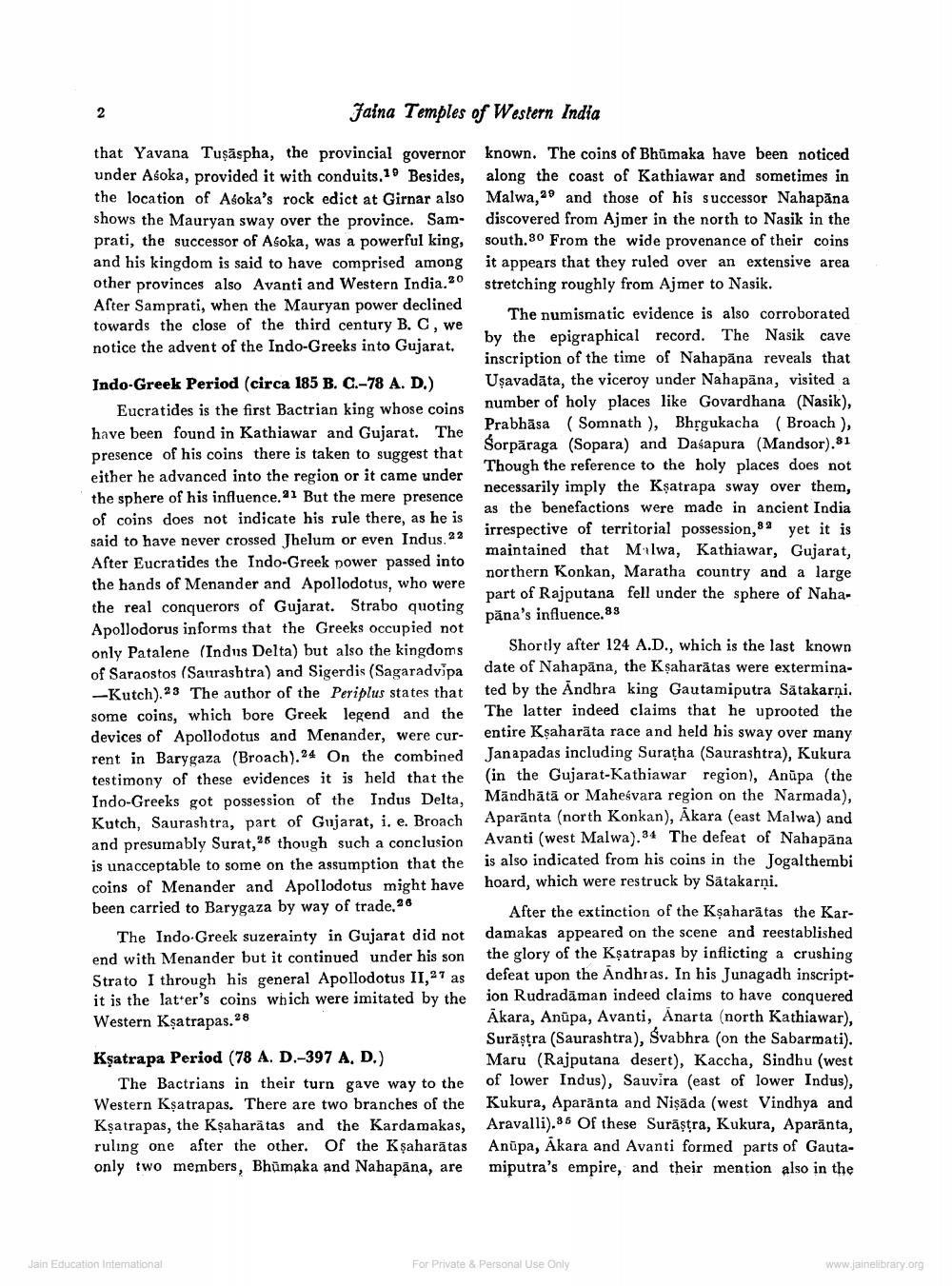________________
Faina Temples of Western India
that Yavana Tuşāspha, the provincial governor known. The coins of Bhūmaka have been noticed under Asoka, provided it with conduits.19 Besides, along the coast of Kathiawar and sometimes in the location of Asoka's rock edict at Girnar also Malwa, 29 and those of his successor Nahapāna shows the Mauryan sway over the province. Sam- discovered from Ajmer in the north to Nasik in the prati, the successor of Asoka, was a powerful king, south.80 From the wide provenance of their coins and his kingdom is said to have comprised among it appears that they ruled over an extensive area other provinces also Avanti and Western India.20 stretching roughly from Ajmer to Nasik. After Samprati, when the Mauryan power declined
The numismatic evidence is also corroborated towards the close of the third century B. C, we notice the advent of the Indo-Greeks into Gujarat
by the epigraphical record. The Nasik cave
inscription of the time of Nahapāna reveals that Indo-Greek Period (circa 185 B. C.-78 A. D.) Uşavadāta, the viceroy under Nahapāna, visited a Eucratides is the first Bactrian king whose coins
number of holy places like Govardhana (Nasik), have been found in Kathiawar and Gujarat. The
Prabhāsa (Somnath ), Bhțgukacha (Broach ), presence of his coins there is taken to suggest that
Sorpāraga (Sopara) and Dasapura (Mandsor).81 either he advanced into the region or it came under
Though the reference to the holy places does not the sphere of his influence.a1 But the mere presence
necessarily imply the Kşatrapa sway over them,
as the benefactions were made in ancient India of coins does not indicate his rule there, as he is
irrespective of territorial possession, yet it is said to have never crossed Jhelum or even Indus. 2 2
maintained that Malwa, Kathiawar, Gujarat, After Eucratides the Indo-Greek power passed into
northern Konkan, Maratha country and a large the hands of Menander and Apollodotus, who were
part of Rajputana fell under the sphere of Nahathe real conquerors of Gujarat. Strabo quoting
päna's influence.83 Apollodorus informs that the Greeks occupied not only Patalene (Indus Delta) but also the kingdoms Shortly after 124 A.D., which is the last known of Saraostos (Saurashtra) and Sigerdis (Sagaradvipa date of Nahapāna, the Kşaharātas were extermina
-Kutch),23 The author of the Periplus states that ted by the Andhra king Gautamiputra Satakarni. some coins, which bore Greek legend and the The latter indeed claims that he uprooted the devices of Apollodotus and Menander, were cur- entire Kșaharāta race and held his sway over many rent in Barygaza (Broach). 24 On the combined Janapadas including Suratha (Saurashtra), Kukura testimony of these evidences it is held that the (in the Gujarat-Kathiawar region), Anupa (the Indo-Greeks got possession of the Indus Delta, Mändhätā or Maheśvara region on the Narmada), Kutch, Saurashtra, part of Gujarat, i, e. Broach Aparänta (north Konkan), Akara (east Malwa) and and presumably Surat, 26 though such a conclusion Avanti (west Malwa).94 The defeat of Nahapāna is unacceptable to some on the assumption that the is also indicated from his coins in the Jogaltherbi coins of Menander and Apollodotus might have hoard, which were restruck by Satakarni. been carried to Barygaza by way of trade, 26
After the extinction of the Kşaharätas the KarThe Indo-Greek suzerainty in Gujarat did not damakas appeared on the scene and reestablished end with Menander but it continued under his son the glory of the Kşatrapas by inflicting a crushing Strato I through his general Apollodotus 11,27 as defeat upon the Andhras. In his Junagadh inscriptit is the latter's coins which were imitated by the ion Rudradaman indeed claims to have conquered Western Kşatrapas.28
Akara, Anupa, Avanti, Anarta (north Kathiawar),
Surāstra (Saurashtra), Svabhra (on the Sabarmati). Kşatrapa Period (78 A. D.-397 A, D.)
Maru (Rajputana desert), Kaccha, Sindhu (west The Bactrians in their turn gave way to the of lower Indus), Sauvira (east of lower Indus), Western Kşatrapas. There are two branches of the Kukura, Aparānta and Nişāda (west Vindhya and Kşatrapas, the Kșaharātas and the Kardamakas, Aravalli).85 Of these Surāṣtra, Kukura, Aparānta, ruling one after the other. Of the Kșaharātas Anūpa, Akara and Avanti formed parts of Gautaonly two members, Bhūmaka and Nabapāna, are miputra's empire, and their mention also in the
Jain Education International
For Private & Personal use only
www.jainelibrary.org




